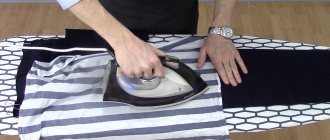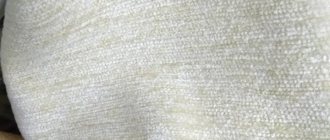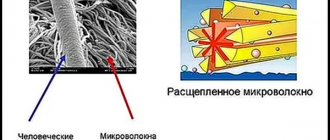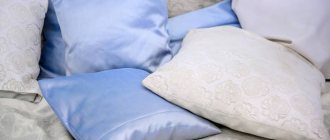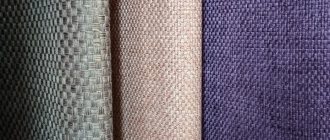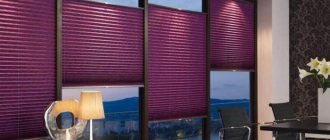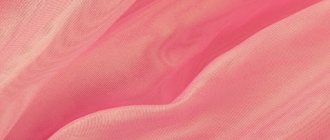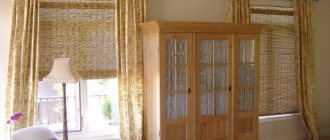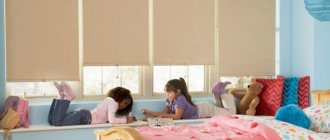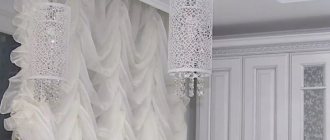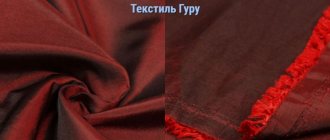Home / Products
Back
Published: 02/05/2021
Reading time: 2 min
3
112
Gabardine curtains are a whole category of fabrics. There is no connection to a specific matter. In this regard, there are models that differ in density, strength, structure and composition. Despite the visual and qualitative differences, this is one category of paintings.
- 1 Description of gabardine fabric for curtains
- 2 How to choose, examples of interior solutions with photos
- 3 Pros and cons of gabardine curtains
- 4 Care tips
- 5 Reviews
- 6 Conclusion
Description of gabardine fabric for curtains
Gabardine for curtains is produced in its pure form or combined with various types of fibers. Thus, the quality characteristics and appearance change.
| Fiber Types | Description |
| Natural | Cotton, wool, silk are used. |
| Mixed | Several types of natural threads are used (cotton with wool), or a mixture of natural and artificial fibers. |
| Synthetic | Polymer products have a characteristic shine. Products made from natural raw materials are matte. |
For information! Artificial impurities reduce the cost of production, so the price of gabardine fabric for curtains is lower than its analogues. In addition, the threads enhance the strength characteristics of the material.
History and properties of gabardine fabric
Gabardine material differs in manufacturing technique, in particular in the method of weaving the threads. Thomas Burberry is considered its discoverer: it was he who began to invent gabardine production technologies. In the old days, Burberry had his own boutique, where he sold sports and outerwear.
Thomas Burberry decides to create a unique waterproof material. The inspiration came from farmers' clothing, made from thick fabric. Looking at it, Burberry came up with the idea of creating a fabric with an interesting name.
So what is gabardine? Initially, this was the name for the capes of the poor, with which they covered themselves in bad weather. Today, gabardine is a dense, practical material that differs in composition and weave of threads. In particular, the threads are intertwined diagonally, at an angle of 40-60°.
Curtains made from this fabric look very beautiful: the back side has a smooth surface, the front side has a harmonious pattern. Thanks to the special weaving of the threads, the fabric is dense, and it also has water-repellent properties: gabardine does not absorb droplets of water falling on the surface.
You can sew not only curtains and bedspreads. Gabardine fabric is used for sewing sports and specialized clothing. Previously, it was in demand among tourists, athletes and fans of an active lifestyle. During the First World War it was used to sew soldiers' uniforms. It is fair to say that this material can also be used for upholstery of upholstered furniture. At first it was created using merino wool, then flax entered production.
It may also be interesting: Calico fabric - what kind of fabric is it?
As for fibers, they are different. Some people prefer fabric made from natural fibers, others buy synthetic ones. A distinctive feature of natural material is the diagonal pattern located on the front side. Synthetic components are visible to the naked eye: the fabric has a characteristic shine. A matte surface indicates the presence of natural fibers.
There are several types of gabardine. Woolen is mainly used for sewing coats. Curtains can be made from gabardine and polyester: this fabric has a smooth surface. In addition, the material varies in thickness: there are thicker and thinner options. It all depends on what threads were used in production. Gabardine has such characteristics as lightness, softness and density.
How to choose, examples of interior solutions with photos
The canvases are universal. Thanks to the variety of shapes, sizes and shades, they highlight the chosen interior.
If you study photos of finished design works, you will notice how stylish the canvases look in any space.
The right fabric will be the final element when creating the decor.
In order for the curtains to complement the chosen style, it is recommended to build on the following rules:
- density. Regardless of the number of threads per cm², curtains do not transmit sunlight well. Used as canvases combined with transparent curtains;
- color. If there are bright fragments in the room (furniture, decor), rich fabrics can “overload” the room. If there is a lack of saturated elements, contrasting material will create a visual accent;
- view. In addition to classic, straight models, there are Roman blinds, drapes, and with photo printing.
Note! The products do not belong to the expensive segment. The price depends on the composition (natural, synthetic).
Examples and real photos of gabardine curtains in the interior
If you look at photographs and examples of the work of experienced designers, you will notice that gabardine looks gorgeous in any interior. Many modern spaces with such “decoration” look more exclusive, radiate coziness and allow you to create the most pleasant living conditions.
Gabardine protects from light by about seventy percent.
If you remember that gabardine is a budget fabric, you might be surprised at its ability to fit elegantly into a space. Studying real photos of curtains created using this material will allow you to be convinced of the magnificence of models of various types.
Gabardine is an ideal material for the production of curtains.
Pros and cons of gabardine curtains
The popularity of the paintings is due to the following qualities:
- light weight. Gabardine for curtains has a high density. Despite this criterion, massive canvases are quite light. No cornice reinforcement required;
- maintaining shape. After deformation, no folds remain. Does not stretch after numerous washes;
- wear resistance. Withstands loads, resistance to mechanical damage and rupture;
- allows air to pass through. Natural circulation is maintained when the curtains are tightly drawn;
- glossy or matte surface. Selected for a specific interior. The presence of shine depends on the components included in the composition.
Along with the advantages, matter has disadvantages:
- partial absorption of light. Regardless of the density of the canvas, they block light by 70%;
- complexity of cutting. When adjusting the length yourself, the edges fall off. It is necessary to leave a small fabric allowance.
For information! Gabardine curtains are invulnerable to UV radiation. Placement on the sunny side is acceptable. Prolonged exposure to direct light does not have a negative effect on brightness.
Gabardine curtains: main features of the material
Gabardine is a material with a long history. This is a durable, dense and very practical fabric, ideal for sewing curtains. Manufacturing technology and fabric composition may vary. An invariable characteristic feature is the thread weaving system - a complex twill, which gives the material a number of excellent properties.
What fibers does gabardine consist of?
Initially, gabardine was exclusively natural wool fabric. The development of the chemical industry and technological progress have made their own adjustments. Today, the composition of fabrics under the same name can vary greatly. It all depends on what threads were used in production. This also applies to gabardine. Today the following options are available:
- woolen;
- half-wool;
- cotton;
- polyester.
Woolen and wool blend options are more often used for tailoring. Polyester gabardine is ideal for photo printing, which is why it is chosen for photo curtains.
Reference! The name gabardine refers not to the composition, but to the method of weaving the threads - complex twill.
Varieties of gabardine fabrics for sewing curtains: photo examples
Curtain fashion is moving forward. Designers work hard to create new trends and annually replenish the arsenal of catalogs with fresh ideas. The choice of model is a matter of taste and style in which the room is decorated. Below are several ideas.
- For a minimalist style, a simple, strict form of curtains with vertical folds on the eyelets is suitable.
- Combinations with contrasting color inserts are an idea that helps to combine dissimilar interior details in one room.
- Massive floor-length curtains, with complex draperies and fringe, with tassels and a rigid lambrequin with an original edge, will fit perfectly into an elaborate rococo style.
- Ensembles with repetition of accessories made from curtain fabric are good - tablecloths, bedspreads, decorative pillows.
- Multilayer compositions made of thick gabardine curtains and weightless tulles look great.
- Models of photo curtains with tulle companion curtains are an innovative idea.
Care Tips
The material is not considered capricious. Thanks to the water-repellent coating, dirt does not penetrate deep into the threads.
However, when cleaning products, it is important to take into account the features of the composition:
- Models containing wool require dry cleaning. It is difficult to follow the cleaning technology on your own. Other types are machine washable;
- use liquid detergents. It is allowed to add mild stain removers without chlorine;
- There are no restrictions on the number of revolutions during spinning. The fabric is resistant to deformation;
- dry in a well-ventilated area. Pre-straighten;
- Ironing is optional. The curtains will return to their original shape under their own weight.
Author:
Anastasia Kukushkina
I hope you enjoy the article I have prepared for you! If you find errors in it, write to me about it! I will answer any questions you have, ask them!
